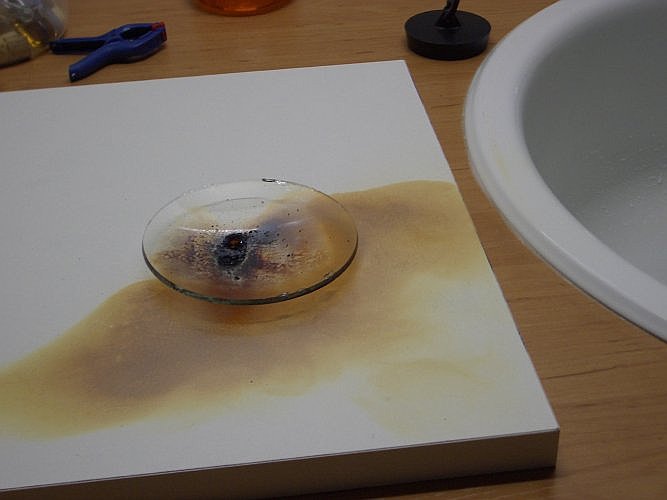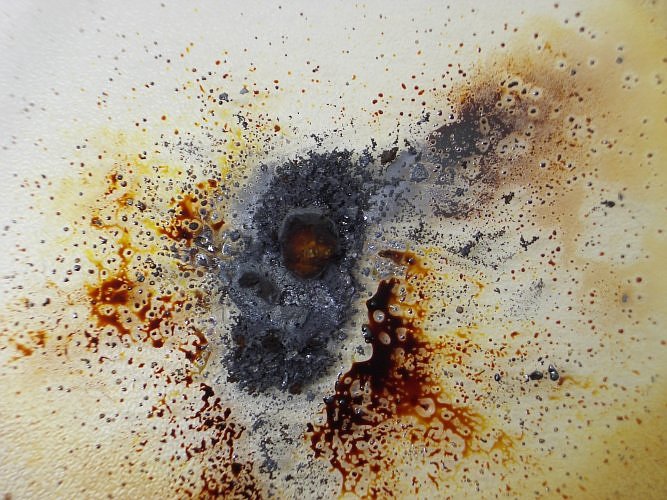


Water-initiated purple vapor
Magnesium and iodine react vigorously with each other, but only in the presence of water. This can be demonstrated with this spectacular experiment.
If this experiment is carried out carefully, then the risks are not really high, but one has to use due care and the experiment should not be scaled up to large quantities!
![]()
![]() Required
chemicals:
Required
chemicals:
-
powdered magnesium, medium fine (particle size 50 - 150 μm)
-
solid iodine
-
sodium sulfite or bisulfite might be necessary for cleaning up the mess after the experiment safely
![]() Required
equipment:
Required
equipment:
-
a piece of glass
- glass rod or plastic rod
![]() Safety:
Safety:
- Powdered magnesium is very flammable.
- Iodine is corrosive and fairly toxic. The vapor produced in this experiment should not be inhaled.
- This experiment produces a lot of brown stain. This experiment should not be performed on a surface, which cannot easily be cleaned by wet means.
-
 Do not scale up
the experiment.
Do not scale up
the experiment.
![]() Disposal:
Disposal:
- After the experiment, assure that all magnesium has reacted with the iodine, by adding drops of water, until no more reaction is observed anymore.
- With some sodium sulfite or bisulfite, the brown stain of iodine can be removed. It is safe to clean brown skin with sulfite, provided that the sulfite is not allowed to act upon the skin for prolonged time.
- Waste can be flushed down the drain, when neutralized with sulfite or bisulfite. Solid waste must also be treated with wet sulfite or bisulfite, before it can be disposed of as ordinary household waste. The waste is not particularly toxic, but if not neutralized well, then incredible stains can be produced.
![]()
Procedure for performing the experiment
![]() Take
a small amount of iodine and a small amount of powdered magnesium. It
might be necessary to crunch the iodine crystals with a glass rod or a hard
plastic rod. Do not use metal tools for handling the iodine. It will spoil the
metal tools. If crunching of crystals is necessary, do this before
mixing.
Take
a small amount of iodine and a small amount of powdered magnesium. It
might be necessary to crunch the iodine crystals with a glass rod or a hard
plastic rod. Do not use metal tools for handling the iodine. It will spoil the
metal tools. If crunching of crystals is necessary, do this before
mixing.

![]()
![]() Mix both solids with an absolutely dry
spatula. The spatula must not be a metal spatula.
Mix both solids with an absolutely dry
spatula. The spatula must not be a metal spatula.
After this step, a small heap of the magnesium/iodine mixture is obtained. Approximately 1.5 cm long, width of 5 mm and 2 mm high in the middle.
![]() Take a
clean glass rod and put the tip in some water. Assure that a drop of water is on
the tip of the glass rod. Put the tip of the glass rod on the magnesium/iodine
mixture, such that the water falls on the middle of the heap of the mixture. As
soon as the water comes in contact with the mixture a violent reaction starts,
in which so much heat is produced that a large part of the iodine vaporizes.
This produces a nice purple cloud of gaseous iodine, which quickly condenses on
anything near the place, where the experiment is conducted and produces a lot of
brown stain. During the reaction between the magnesium and the iodine a soft
hissing noise is produced. Although quite some heat is produced, no signs of
fire can be observed. The following two pictures show the violent reaction, just
after putting the drop of water on the mixture and the brown stains, which are
formed by condensation of iodine from the purple cloud.
Take a
clean glass rod and put the tip in some water. Assure that a drop of water is on
the tip of the glass rod. Put the tip of the glass rod on the magnesium/iodine
mixture, such that the water falls on the middle of the heap of the mixture. As
soon as the water comes in contact with the mixture a violent reaction starts,
in which so much heat is produced that a large part of the iodine vaporizes.
This produces a nice purple cloud of gaseous iodine, which quickly condenses on
anything near the place, where the experiment is conducted and produces a lot of
brown stain. During the reaction between the magnesium and the iodine a soft
hissing noise is produced. Although quite some heat is produced, no signs of
fire can be observed. The following two pictures show the violent reaction, just
after putting the drop of water on the mixture and the brown stains, which are
formed by condensation of iodine from the purple cloud.


The magnesium/iodine mixture did not react completely. The following close up nicely shows the different colors of the material produced. The colors are due to formation of iodide, which gives red/brown complexes with iodine (e.g. tri-iodide). The grey matter is still unreacted mixture, which can be used for similar experiments, by putting additional drops of water on it.

A little video was made from another run of the experiment, with 115 mg of iodine and 15 mg of magnesium powder. Click here for the video.
![]()
Discussion of results
![]() Magnesium and iodine react with each other as follows:
Magnesium and iodine react with each other as follows:
Mg + I2 → MgI2
This reaction is highly exothermic. However, in order to have a reasonable reaction rate, the magnesium and the iodine need to be in intimite contact. The water helps accomplishing this. At first some iodine dissolves in the water, which reacts with magnesium. The magnesium iodide formed dissolves in the water, allowing much more iodine to be dissolved as tri-iodide:
I–(aq) + I2(s) → I3–(aq)
The tri-iodide reacts with further magnesium, by splitting off iodine and forming more magnesium iodide. This reaction is self-accelerating.
The last close up picture nicely shows the red/brown tri-iodide, dissolved in a small amount of water.